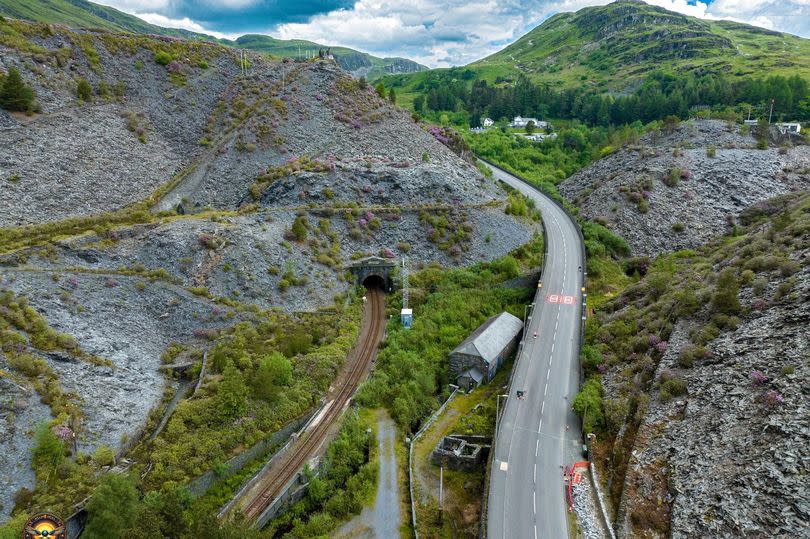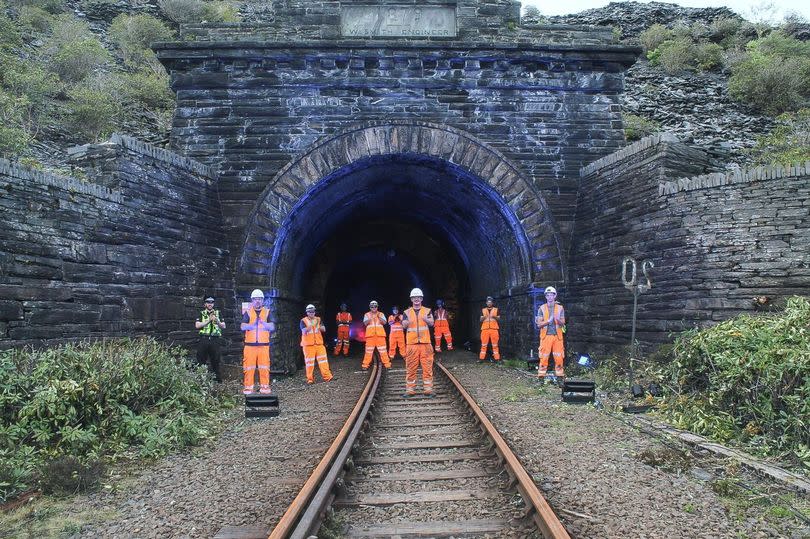This epic 2.5-mile tunnel changed one part of Wales forever

While it may not quite match the grandeur of the Alpine tunnel that guides Bernina Express trains over the Landwasser Viaduct, the Ffestiniog Tunnel in Wales is a sight to behold due to its stunning surrounding countryside. Constructed in the 1870s, this Victorian marvel has stood the test of time.
The tunnel stretches for 2.5 miles underground from Blaenau Ffestiniog, located in one of the most challenging parts of the Conwy Valley Line. Despite its future being questioned multiple times, the tunnel remains operational and continues to defy expectations.
Carved through slate bedrock, the Ffestiniog Tunnel was once the longest unlined tunnel in Europe and still holds the title in the UK. The railway line, which transports trains between Blaenau and Llandudno Junction, reaches its highest point at 790ft midway through the tunnel.
Read more: The hidden Welsh waterfall so stunning it regularly stars in Hollywood films
Read more: Woman returns to Welsh hometown and is 'disgusted' by what she finds
Due to its location in an area with high rainfall and the fact that it's unlined, the tunnel has faced numerous issues over the years including water ingress, rockfalls and landslides. It had to be closed for extended periods in 2017 and 2019, reports North Wales Live.
At one stage, with expensive repairs required, it seemed like the end was near. Rail enthusiasts often joked that the tunnel was closed more often than it was open. However, in 2019, Network Rail approved a £2.1m rockfall protection netting system.
This appears to have solved the problem. Griffiths Civil Engineering, the contractor responsible for the project, used innovative techniques to tackle the challenges of working in a 2.5-mile, single-track tunnel where fumes, dust and rockfalls were constant hazards.
The project specifically targeted a section of the tunnel referred to in historical drawings as the "bastard slates". From 1873 to 1879, two teams of labourers at each end had hauled away 300,000 tonnes of stone, progressing an average of 8.4ft per day till they encountered the incredibly hard slates at the heart of the structure.
The slate bed found there is notorious even among current engineers for rapidly wearing out drill bits. Traditional hand drilling would take around an hour just to secure one two-metre bolt and for the new rock protection netting, a whopping 600 stainless steel rock bolts, each stretching 2.5 metres, were required.
To contend with this formidable obstacle, Griffiths employed rail-mounted hydraulic drill rigs. "This reduced drill times to under 10 minutes," the company revealed back then. At the same time, misting units worked to suppress dust and the use of a low-emission fuel minimised emissions of carbon dioxide and nitrogen oxides. These state-of-the-art solutions are reminiscent of the innovations ushered in during the tunnel's original construction when steam-powered drills and ventilation systems were introduced.
The challenges of maintaining the tunnel are minor compared to those further up the line, where the railway runs perilously close to the River Conwy. Over the years, flooding has led to multiple closures, often for extended periods. The most recent disruption in April was resolved in just four days, thanks to Network Rail engineers working tirelessly to replace over 200 tonnes of ballast washed away near Dolgarrog station.

The southern entrance of the Ffestiniog Tunnel is located across the A470 from Zip World Llechwedd, a significant tourist attraction. Most visitors arrive by car, with only a few making the 1.5-mile journey to the town centre. This not only contradicts the Welsh Government's climate agenda but also does little to stimulate Blaenau's economy.
Since 1976, rail enthusiasts have speculated about the possibility of connecting Llechwedd to the town centre by restoring an old branch line from Blaenau to Dinas that was removed in the 1950s. The plan was to construct a new station and run specialist rolling stock up the incline to the quarry.
However, nearly half a century later, the project remains on hold due to escalating costs and doubts over its commercial viability. A more cost-effective proposal was put forward two years ago by rail expert Chris Baker, a retired engineering professor. He suggested utilising the existing Conwy Valley Line to operate shuttle services between Blaenau and Llechwedd. To eliminate the need for a foot crossing over the A470, this would necessitate a new platform at Llwechwedd.
He highlighted the underused potential of the track, noting that the section from Roman Bridge was only in use for 45 minutes every three hours. On his blog, he suggested: "With a little imagination in the development of a signaling system to ensure safety, I would suggest that the line between the town centre and Dinas could be used for a shuttle service.... when that section of track is not occupied."
Professor Baker proposed an innovative solution by suggesting the installation of a narrow-gauge track within the existing standard gauge, which would allow the use of Ffestiniog trains. However, he pointed out that the main obstacle was Network Rail's complex approvals process.
The Conwy Valley Railway, stretching 27 miles, was originally constructed to transport slate from the Ffestiniog quarries to Deganwy quay for maritime export, with up to 500 tonnes of slate being sent daily (the extension to Blaenau Ffestiniog came later). Initially planned as a narrow-gauge railway, a last-minute decision to adopt standard gauge significantly influenced the region, boosting the slate industry, providing a trade route for Llanrwst, and expanding the horizons for residents of rural Eryri.
The railway also brought a significant boost to the budding tourism industry in the area, with a major station developed in Betws-y-Coed. The lasting impact of the hardy workers who conquered the "bastard slates" to construct what was once Europe's longest unlined tunnel is still evident today.

 Yahoo News
Yahoo News 
